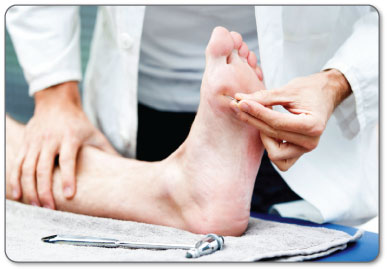Has it been weeks or months since the injury?
An acute (recent) case of sesamoiditis is usually treated with conservative treatment methods, like rest, minimizing activity, cold compression and Blood Flow Stimulation Therapy™ as we mentioned before.
If you have a fracture that's not healing of you have a fracture that puts your bone in multiple pieces, your surgeon might perform a sesamoidectomy (removal of the sesamoid bone).
Scar tissue will be problematic for long-term recovery after surgery.
As with any surgery there are risks to every procedure depending on a lot of factors, including your age, the severity of your injury and your level of health going into the procedure. It's always best to discuss all possible risks and complications with your doctor, orthopaedic specialist and/or surgeon before the procedure. It's important to be aware of the risks you may face with any procedure intended to fix or relieve pain from your sesamoiditis.
Sesamoidectomy
If you suffer from a regular (acute) fracture or stress (chronic) fracture in your sesamoid bone and conservative treatment methods haven't been successful in healing or relieving pain, then your doctor may suggest a sesamoidectomy surgery. During this procedure your fractured or injured sesamoid bone (or pieces of the bone) will be removed. Removal of this bone is meant to ease pain and promote healing in the area.This procedure will be done by making an incision on the side of your big toe. The surgeon will then seperate all of the underlying soft tissues to get to your sesamoid bones and visually inspect it. Once removing some or all of your sesamoid bone the surgeon will use sutures to attach the end of the tendons together or connect it to the remaining bone.

This is why doctors encourage conservative treatment methods first, and surgery only second IF the conservative methods of healing don't work.
Sesamoid Bone Graft Surgery
The only other option for sesamoid surgery is a bone graft. This is usually only performed when you continue to have issues with a stress (chronic) fracture in your sesamoid bone(s). During this procedure your surgeon will take some bone from big toe (this is called an 'autogenous bone graft') through a second incision, and then use that bone to repair the areas that aren't healing properly in your sesamoid.Sesamoidectomy is always preferred over a bone graft as it's a minimally invasive surgery. This bone graft procedure is also only ever considered for high performance athletes.
surgery is, the quicker your road to recovery will be.

- Sesamoidectomy - You may need to wear a cast for 2 to 3 weeks, then follow that with a walking brace for another few weeks. Physical therapy can start 2 to 3 weeks after your surgery and you may be able to return to some modified form of your regular activity by week 8.
- Sesamoid Bone Graft Surgery - This procedure will have a longer recovery period, starting with you wearing a cast for 3 to 4 weeks. That's followed by a walking cast or boot to be worn for another 3 to 4 weeks. Physical therapy may start anywhere from 4 weeks after surgery to 8 weeks after surgery. Other assistive devices like orthotics or arch supports may be prescribed to help you along with your recovery.
I really impressed after read this because of some quality work and informative thoughts . I just wanna say thanks for the writer and wish you all the best for coming!. Dr.Baiju
ReplyDeleteThis is a great inspiring article.I am pretty much pleased with your good work.You put really very helpful information. Keep it up. Keep blogging. Looking to reading your next post. where can you buy herbalife
ReplyDeletei am always looking for some free stuffs over the internet. there are also some companies which gives free samples. MD In Philippines
ReplyDeleteThank you again for all the knowledge you distribute,Good post. I was very interested in the article, it's quite inspiring I should admit. I like visiting you site since I always come across interesting articles like this one.Great Job, I greatly appreciate that.Do Keep sharing! Regards, pediatric stethoscope reviews
ReplyDeleteGreat write-up, I am a big believer in commenting on blogs to inform the blog writers know that they’ve added something worthwhile to the world wide web!.. reduce cortisol
ReplyDeleteI was playing semi-pro soccer in 2019. I had a sesamoidectomy in 2020 removing one of the sesamoid bones because it had been fractured for about a year. I had surgery again in July 2021 because the first surgery never healed correctly even with taking my time and then doing rehab 4-8 weeks out (I cant remember the exact week). The doctor said everything looks in place after the second surgery but I still cannot run even until today. I can bend my toe with my hands very far forward and back but not when I try to run, there is excruciating pain when I spring off of my left foot. This issue has been going on for about 2 years. Has anyone ever seen or heard of anything similar to my situation? Thank you.
ReplyDeleteplease help if this situation sounds similar to anything you have heard before. My email is titansjan10@aol.com
ReplyDelete